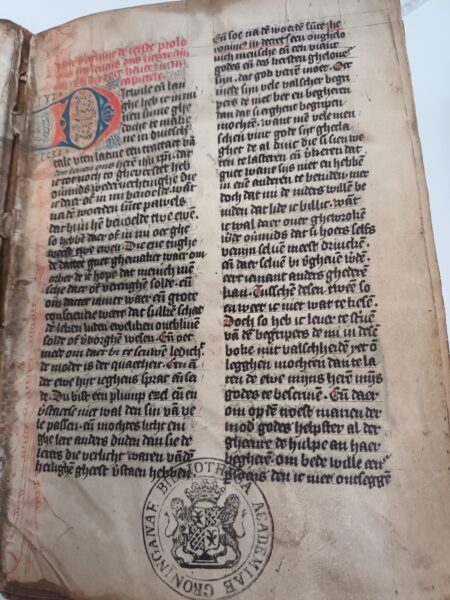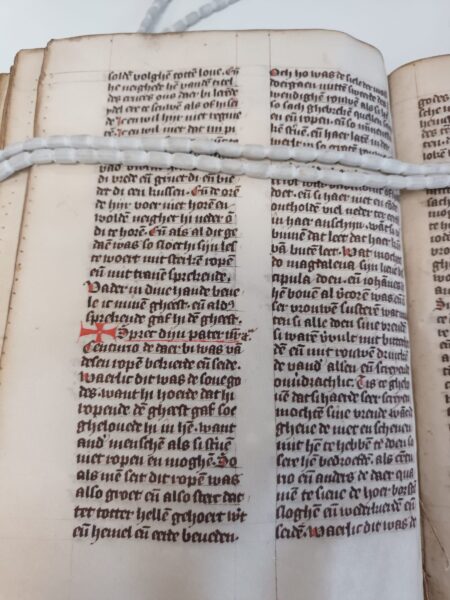This location, on the Rode Weeshuisstraat, is where the Olde Convent, also known as the Saint Agnes Convent or the Spiritual Virgins Convent, could be found until 1599. In the year 1438, Hille Baroldii (or Baereldes) gave a handwritten book about TLeven ons heren Jhesu Christi (The life of our Lord Jesus Christ) to the sisters of the Olde Convent in Groningen. There is some barely legible handwriting at the bottom of the last page of this book:
Dit boek heeft Hille Baroldii den susteren in den Olden Convente in Groninghen gegeven, betet voer hoer. Int jaer ons heren MCCCC ende XXXVIII in Witten Dondredage.
It says that on Maundy Thursday in the year 1438 (i.e. April 10), Hille Baroldii donated this book to the sisters in the Olde Convent at Groningen, who should pray for her.
Hille Baroldii gave this book to the Olde Convent that used to be here, on the Rodeweeshuisstraat. At the beginning of the 15th century, this small street was also called the Begijnenweg, and later the Geestelijke Maagdenstraat or Hardewikstraat. This is why the Olde Convent is also known as the Saint Agnes Convent or the Geestelijk Maagdenconvent (Spiritual Virgins Convent). It was established as a beguinage around 1386. A beguinage was intended for women who wanted to live in poverty and chastity, and therefore had to live on alms and the work they did with their own hands. They usually did not belong to a specific religious order and they were not part of the church council. In other words, beguines opted for a middle course between a spiritual and a secular life. Sometimes a beguine community felt the need to form a closer unit: a convent community. In 1399 or 1401, the convent joined the Third Order of Saint Francis; the members of this order were also called tertiaries. This means that the sisters did not have to take the official vows of poverty, chastity, and obedience, even though this became more and more customary in practice. The Third Order is based on the poverty ideal as preached by Francis of Assisi.
This order was intended for women and men who lived in the secular world, and was therefore suitable for beguines. Laymen could also join this order. In general, the sisters of the Olde Convent belonged to a lower social class than the sisters of the other medieval tertiary convents in the city of Groningen: the Vrouw Menoldisconvent (the city’s oldest beguinage) and the Vrouw Sywenconvent. These convents were nearby, on the Broerstraat and the Kijk in ’t Jatstraat.
As a result of the Reduction of Groningen in 1594 (when the city became Protestant), the buildings and the possessions of the Olde Convent, and those of the other convents in Groningen, were transferred to the States of Stad en Lande (the current province of Groningen), which handed the buildings over to the city of Groningen in 1599. Some of the buildings were assigned to the Burgerweeshuis that had been established in the same year. The Burgerweeshuis was also called the Red Orphanage, because of the colour of the clothes worn by the orphans. This is how this street got its current name: Rodeweeshuisstraat.

TLeven ons Heren Jhesu Christi is a translation into Middle Dutch of the Latin Vita Christi, which focuses on the life of Jesus and which was widely distributed in the Low Countries. This book was read very often within and outside convents. The text has been copied many times and is also known as the Pseudo-Bonaventure-Ludolphian Life—named after Bonaventure and Ludolph of Saxony, to whom the text (originally written in Latin) is attributed. The former was a Franciscan theologian and philosopher from Italy, who dedicated his life and work to Christ and his suffering. Ludolph of Saxony was a German monk and theologian who lived from around 1295 until 1378. He took the view that believers should use their imagination to try and experience the life of Christ as if they were present at it. This view is clearly reflected in TLeven ons Heren Jhesu Christi: the book contains detailed instructions on how to contemplate on the events surrounding the suffering and death of Christ. In other words, believers should take the time to contemplate the life of Jesus in the days around Good Friday and Easter. Readers were expected to imagine the passages with ‘a sad, weeping heart’ (drovighen screyenden herten) as if they were ‘present at the events’ (ieghenwordich).
We do not know much about Hille Baroldii, who donated this book. Was she from a family of mayors of Groningen, as some researchers claim? Was she the wife of mayor Hindrick Baroldes, as seems to be suggested by a deed in the Municipal Archives of Groningen? A third possibility is that she was actually a sister in the Olde Convent.
Author: Frida van Til










